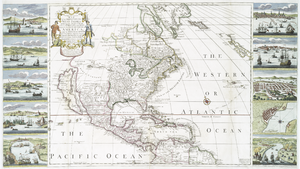
Back حرب أذن جينكنز Arabic Guerra del Asientu AST Война за ухото на Дженкинс Bulgarian Brezel skouarn Jenkins Breton Guerra de l'Orella de Jenkins Catalan Válka o Jenkinsovo ucho Czech War of Jenkins’ Ear German Guerra del Asiento Spanish Anglo-espainiar Gerra (1739-1748) Basque Sota Jenkinsin korvasta Finnish
| War of Jenkins' Ear | |||||||
|---|---|---|---|---|---|---|---|
| Part of the War of the Austrian Succession | |||||||
 Trade map of the West Indies and North America during the war, 1741 | |||||||
| |||||||
| Belligerents | |||||||
|
|
| ||||||
| Commanders and leaders | |||||||
| |||||||
| Casualties and losses | |||||||
|
20,000 dead and wounded, majority from disease outbreaks 407 ships lost[2] |
4,500 dead, 5,000 wounded, 186 ships lost[citation needed] | ||||||
| Wars of Great Britain |
|---|
 |
| History of Spain |
|---|
 |
| Timeline |
The War of Jenkins' Ear (Spanish: Guerra del Asiento, lit. 'War of the Agreement') was a conflict lasting from 1739 to 1748 between Britain and Spain. The majority of the fighting took place in New Granada and the Caribbean Sea, with major operations largely ended by 1742. It was related to the 1740 to 1748 War of the Austrian Succession. The name was coined in 1858 by British historian Thomas Carlyle,[3] and refers to Robert Jenkins, captain of the British brig Rebecca, whose ear was allegedly severed by Spanish coast guards while searching his ship for contraband in April 1731.
Response to the incident was tepid until opposition politicians in the British Parliament, backed by the South Sea Company, used it seven years later to incite support for a war against Spain, hoping to improve British trading opportunities in the Caribbean.[4] They also wanted to retain the lucrative Asiento de Negros, a contract issued by Spain to British merchants granting them permission to sell slaves in Spanish America, which is why the Spanish call it the Guerra del Asiento.[5] The failed British attack at the Battle of Cartagena de Indias in 1741 resulted in heavy British casualties, primarily from disease and was not repeated.[6]
Apart from minor fighting in Florida, Georgia and Havana, after 1742 the conflict was largely subsumed into the War of the Austrian Succession, which involved most of the powers of Europe, and ended with the 1748 Treaty of Aix-la-Chapelle. Great Britain failed to achieve its territorial and economic ambitions,[7] and Spain successfully defended its possessions in the Americas.[8][9] The war is remembered in British naval history for Admiral George Anson's voyage around the world from 1740 to 1744.
- ^ Bemis, Samuel Flagg (1965). A Diplomatic History of the United States. Holt, Rinehart and Winston. p. 8.
- ^ Newman, Gerald; Brown, Leslie Ellen (13 November 1997). Britain in the Hanoverian Age, 1714-1837: An Encyclopedia. Taylor & Francis. ISBN 9780815303961.
All in all, the war cost Britain 20,000 casualties and 407 ships, primarily merchantmen, in exchange for little commercial or strategic gain.
- ^ Carlyle discusses Jenkins' Ear in several passages of his History of Friedrich II(1858), most notably in Book XI, chap VI, where he refers specifically to "the War of Jenkins' Ear"
- ^ Graboyes & Hullar 2013, pp. 368–372.
- ^ Olson 1996, pp. 1121–1122.
- ^ Webb 2013, pp. 396–398.
- ^ "Spain's fortifications, fleet and merchant marine were able to repel Great Britain's offensive. England's design to detach the Americas from the Spanish monarchy failed, for the Treaty of Aix-la-Chapelle, which ended the war in 1748, left the Spanish empire intact while cancelling British trading privileges in Spanish territory". Chavez, Thomas E.: Spain and the Independence of the United States: An Intrinsic Gift. Albuquerque: University of New Mexico Press, 2004, p. 4. ISBN 9780826327949
- ^ "The Spanish archives reveal that Spain was not prepared for war but willing to take measures to defend her colonies in America. Her men fought well, and for the most part successfully, when the chips were down. That they were aided, in part, by English errors and indecision, should not detract from their victories". Naval History (1680 - 1850), edited by Richard Harding, 2006
- ^ Ogelsby 1970
© MMXXIII Rich X Search. We shall prevail. All rights reserved. Rich X Search